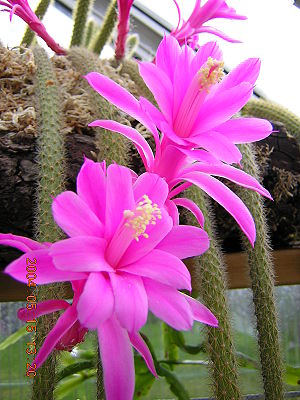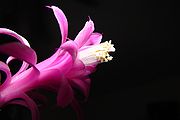- Trochilocactus
-
Disocactus Systematik Unterklasse: Nelkenähnliche (Caryophyllidae) Ordnung: Nelkenartige (Caryophyllales) Familie: Kakteengewächse (Cactaceae) Unterfamilie: Eigentliche Kakteen (Cactoideae) Tribus: Hylocereeae Gattung: Disocactus Wissenschaftlicher Name Disocactus Lindl.  Habitus von Disocactus flagelliformis.
Habitus von Disocactus flagelliformis.Disocactus ist eine Pflanzengattung in der Familie der Kakteengewächse (Cactaceae). Der botanischer Name leitet sich vom griechischen Worten „δίς“ (dis) für zweimal und „ίσος“ (isos) für gleich ab. Er verweist auf die blattartig abgeflachten (zwei-gleichseitigen) Triebe.
Inhaltsverzeichnis
Beschreibung
Die Arten der Gattung Disocactus wachsen epiphytisch oder lithophytisch und sind strauchig. Die Triebe sind gerippt oder abgeflacht und blattartig. Der nahe der Basis drehrunde Haupttrieb ist nur oben abgeflacht, während die Seitentriebe vollständig abgeflacht sind. Die darauf befindlichen Dornen sind borstig oder fehlen.
Die großen, sich am Tag öffnenden Blüten erscheinen einzeln oder selten zu mehreren aus einer Areole. Sie sind von unterschiedlicher Form und Größe. Die Blüten sind trichter- oder röhrenförmig, manchmal zygomorph und nur selten radförmig. Sie sind leuchtend rot, rosa-orange, hellgelb gefärbt oder weiß. Die Staubblätter stehen oft in zwei Reihen, wobei die oberen manchmal einen deutlichen Schlundkreis bilden.
Es werden beerenartige Früchte gebildet, die fast kahl oder mit wenigen kleinen Schuppen bedeckt sind. Sie enthalten breit eiförmige Samen von 1,5 bis 2,4 Millimeter Länge und 1 bis 1,7 Millimeter Breite. Die Samen sind braunschwarz bis fast schwarz und sind glänzend oder seltener etwas matt.
Systematik und Verbreitung
Die Gattung Disocactus ist hauptsächlich in Mittelamerika, aber auch in Mexiko, der Karibik und im Norden Südamerikas verbreitet.
Die Erstbeschreibung wurde 1845 von John Lindley veröffentlicht.[1] Zur Gattung gehören die folgenden Arten:[2]
- Untergattung Ackermannia
- Disocactus ackermannii
- Disocactus ackermannii f. candidus
- Disocactus ackermannii subsp. ackermannii
- Disocactus ackermannii subsp. conzattianus
- Disocactus aurantiacus
- Disocactus cinnabarinus
- Disocactus kimnachii
- Disocactus ackermannii
- Untergattung Aporocactus
- Disocactus flagelliformis
- Disocactus martianus
- Disocactus schrankii
- Disocactus speciosus
- Disocactus speciosus f. amecaensis
- Disocactus speciosus f. speciosus
- Untergattung Disocactus
- Disocactus biformis
- Disocactus eichlamii
- Disocactus macranthus
- Disocactus nelsonii
- Disocactus nelsonii var. nelsonii
- Disocactus nelsonii var. hondurensis
- Disocactus quezaltecus
- Untergattung Nopalxochia
- Disocactus macdougallii
- Disocactus phyllanthoides
Ohne Zuordnung sind die Hybriden:
- Disocactus ×hybridus
- Disocactus ×mallisonii
- Disocactus ×violaceus
Nachweise
Literatur
- Edward F. Anderson: Das große Kakteen-Lexikon. Eugen Ulmer KG, Stuttgart 2005 (übersetzt von Urs Eggli), ISBN 3-8001-4573-1, S. 182–187.
Einzelnachweise
- ↑ Edwards's Botanical Register; or, Flower Garden and Shrubbery. Band 31, Tafel 9, London 1845
- ↑ Edward F. Anderson: Das große Kakteen-Lexikon. Eugen Ulmer KG, Stuttgart 2005 (übersetzt von Urs Eggli), ISBN 3-8001-4573-1, S. 182–187.
Weiterführende Literatur
- Wilhelm Barthlott: Disocactus, Lepismium and Pseudorhipsalis. In: D. R. Hunt, N. Taylor (Hrsg.): Notes on miscellaneous genera of Cactaceae. In: Bradleya. Band 9, 1991, S. 81–92
- Ralf Bauer: A synopsis of the tribe Hylocereceeae F. Buxb. In: Cactaceae Systematics Initiatives. Band 17, S. 3-63, 2003
- Myron William Kimnach: The genus Disocactus. In: Haseltonia. Band 1, 1993, S. 95–139
Weblinks
- Untergattung Ackermannia
Wikimedia Foundation.


